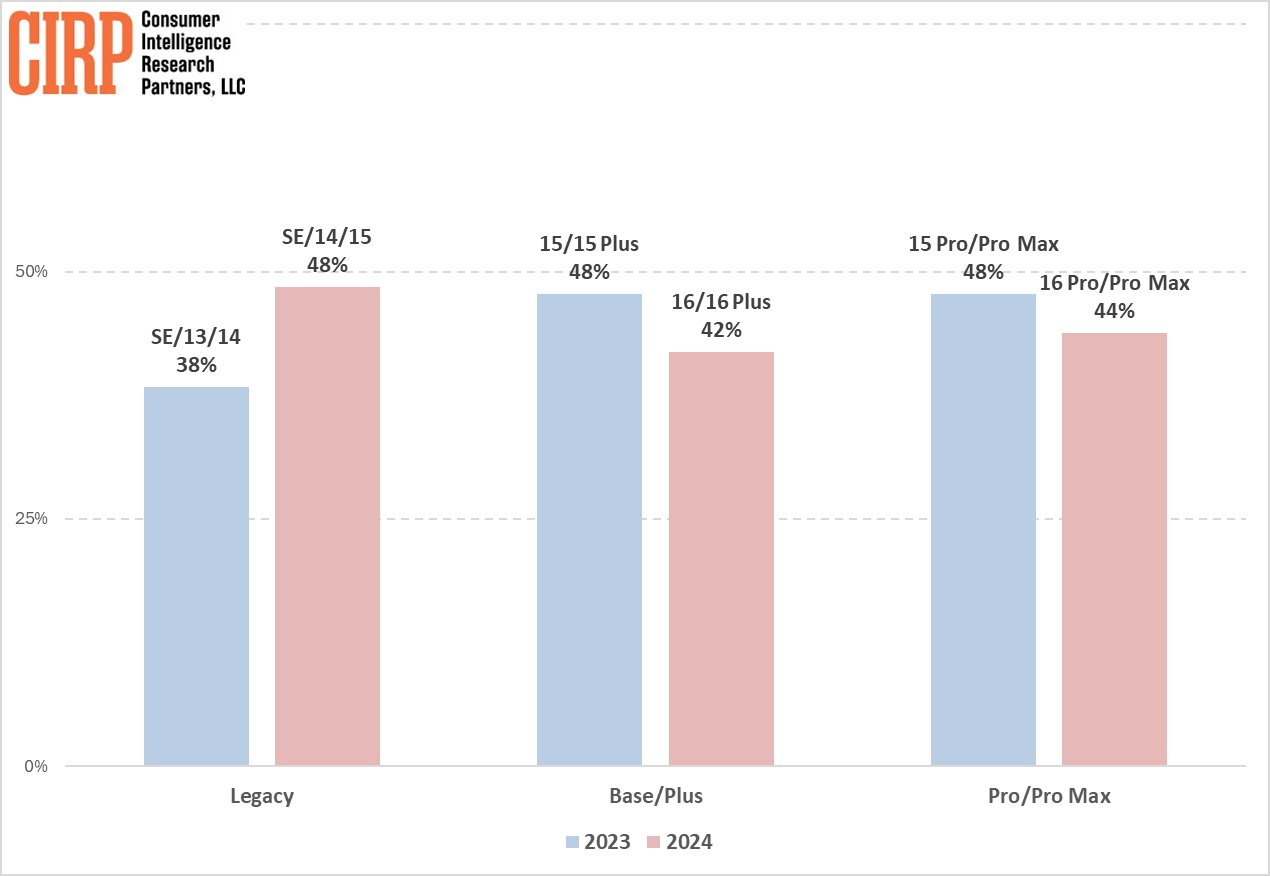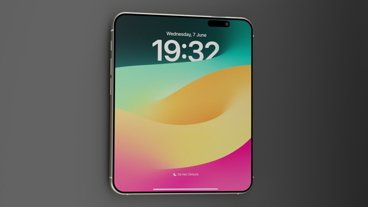Fewer iPhone buyers are paying for extra storage, signaling a shift toward cloud reliance that could shake up one of Apple's most profitable upsells.
Apple has long relied on iPhone storage upgrades as a revenue driver. The strategy is simple — offer a base storage option that's "good enough" while enticing users with pricier upgrades.
But recent data suggests that fewer people are biting. According to a Consumer Intelligence Research Partners (CIRP) report, storage upgrades have dropped across the board for the latest iPhone models, signaling a shift in consumer behavior.
A subtle but significant decline
In the holiday 2024 quarter, 44% of iPhone 16 Pro and Pro Max buyers paid for additional storage, down from 48% in the same period a year earlier with the iPhone 15 Pro models. The trend is even more pronounced for standard iPhone 16 and 16 Plus models, where just 42% opted for more storage, compared to 48% for the iPhone 15 and 15 Plus in 2023.
At first glance, a four- to six-percentage-point drop might not seem like much. But considering Apple charges anywhere from $100 to $500 per upgrade, it represents a meaningful financial shift.
 Percentage of iPhone buyers choosing more storage by model (December 2023 vs. 2024). Image credit: CIRP
Percentage of iPhone buyers choosing more storage by model (December 2023 vs. 2024). Image credit: CIRPIf fewer people feel the need for more space, Apple's high-margin storage business could see a real impact.
Why are buyers resisting upgrades?
One explanation is that Apple's base storage tiers have finally caught up with real-world needs. The iPhone 16 Pro Max starts at 256GB, double the 128GB entry point for most other models.
Even Apple's cheapest iPhone, the SE, now ships with 64GB. That's a long way from the days when users had to delete apps and photos just to install a software update.
Beyond that, cloud reliance has changed the game. With fast Wi-Fi, 5G, and seamless integration with iCloud, local storage just isn't as essential as it used to be.
Streaming services have largely replaced offline music and video libraries, and cloud-based photo management means users don't need to store years' worth of images on their devices. For many, the base storage is plenty, making an upgrade unnecessary.
The unexpected rise in storage upgrades for older models
Interestingly, while high-end and mainstream iPhone buyers are skipping upgrades, legacy iPhone buyers are doing the opposite. More people who purchased an iPhone 15, 14, or SE in the past quarter opted for extra storage compared to 2023.
There are a couple of possible reasons. Some of these users may be upgrading from much older models with smaller storage limits and don't want to repeat the frustration of running out of space.
Others might plan to hold onto their phones longer, making a storage upgrade feel like a smart, long-term investment. Since they're already spending less on their device, the extra $100 or so for more storage might not feel like a major stretch.
What this means for Apple
Apple has always thrived on hardware upselling, and storage has been one of its most profitable add-ons. But as consumer habits change, the company may need to rethink how it pushes upgrades.
While other premium features — like better cameras, longer battery life, and new AI capabilities — still drive purchases, storage might not hold the same allure.
Apple might be selling fewer storage upgrades, but that doesn't mean it's losing out entirely. More people relying on the cloud means more people paying for iCloud+, which starts at just a few bucks a month.
Over time, that kind of steady subscription revenue can be even more profitable than a one-time storage upgrade. Plus, the more users store their photos, backups, and files in iCloud, the harder it becomes to leave Apple's ecosystem.
So even if hardware margins take a hit, the company still wins in the long run. The question now is whether Apple adjusts its strategy or doubles down on services like iCloud+ to make up for the lost hardware revenue.
 Andrew Orr
Andrew Orr

-m.jpg)






 Marko Zivkovic
Marko Zivkovic
 Mike Wuerthele
Mike Wuerthele
 Christine McKee
Christine McKee
 Amber Neely
Amber Neely
 Wesley Hilliard
Wesley Hilliard

 William Gallagher
William Gallagher










11 Comments
This was bound to happen. The doubling of storage isn't going to match user's increased storage needs. The OS isn't doubling each year, we now have HEIC and H.265 that halved media sizes for a given quality, and we have more people using cloud services which helps offload a lot of data that you don't need locally.
I would also imagine that buyers aren't buying as frequently as the very mature 18yo iPhone (and 15yo iPad) simply don't move the needle as much as they did early on. Hell, even the Apple Watch is a decade old. Anecdotally, I was someone that used to get a new Mac notebook and iPhone every release cycle but these devices are so mature and so robust that that eventually moved to every other release cycle and then every 3, and now I'm 3 generations back on my M1 Mac notebook and iPhone 14 and I'm not seeing a need to upgrade this year if anything else comes out. It's great for me, but not so much for Apple's bottom line in the shorter term.
iCloud+ has been a good reliable service for me, and the cost is pretty decent. Most consumers would have forgotten/forgiven Apple for how clunky the original switchover was from iTunes and I don’t miss that lame sync to save data followed by another to back up the Mac. These days I just have a full subscription to Apple One premier - every time I look at trimming subscriptions they keep me sucked into the ecosystem as I realise we actually use all the services on offer.
Again (and again), you have to take any "data" reported by CIRP and other companies like it with a boulder-size grain of salt. Think of how ridiculous this is: with no hard sales data from Apple--which, even if they have spot checks at other retailers, means it is totally blind to whatever is sold in Apple stores or via Apple.com--CIRP is claiming that it can accurately track a 4% drop in demand for storage from one year to the next. They don't even claim a margin of error for their figures! No, they're perfect. And how can they possibly do this? Oh, that's a secret. Give me a break.
Is it possible they're right? Sure. Even a broken clock tells precisely the right time twice a day.
Considering the ridiculous amounts they charge for storage upgrades it is not surprising people are reluctant to upgrade. I'm pretty sure if Apple halved what they currently charge people would start upgrading their storage again. Likewise on the Mac.
Even if it were possible, Apple is in the midst of making a shift as a hardware company to a hardware & services company. iCloud+ subscriptions for storage will more than make up for the much smaller percentage of people reducing that demand.
Also, there is a cite for "people not needing as much space." Which is simply not true. Storage gets cheaper every year, but the upgrade of local iPhone storage does not. How many people at the higher levels (not legacy) maybe sync to a cloud service (whether iCloud, Google, or another), or backup to a hard drive or memory stick?
This "study" reeks of cherry picking and selection bias to reach it's pre-determined click-bait result that a company that makes hundreds of billions of dollars a year is in trouble.